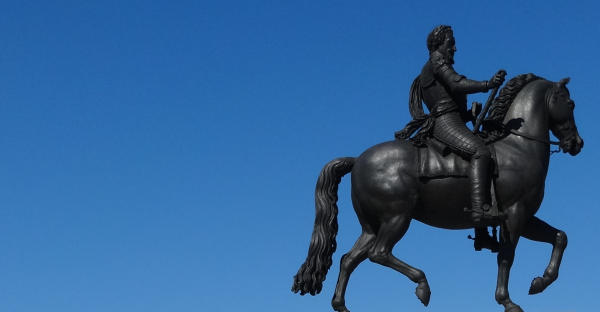
Each year France’s High Committee for National Commemorations selects about 100 anniversaries, multiple of 50 years, that are considered significant in the history of France.
I’ve selected 30—saints, queens, and musicians, assassinations, treaties and war, slavery, gastronomy and science—that give insights into various aspects of French history, culture and politics. These people and events aren’t all known to the general public in France, far from it, and many will seem obscure to the average visitors. Yet each in his/her/its own way has contributed to the culture and conversation that one encounters in France today.
Along with a brief description of their place in history you’ll discover here ways in which you can come into contact with that history as you travel in France. Also keep an eye and an ear out for other related sights, exhibitions, books, articles, documentaries and concerts in the coming year.
418
Saint Germain becomes bishop of Auxerre
There are a number of Saint Germains yet the most famous of these is Saint Germain of Auxerre, who played an important role in the helping the Church of Rome gain primacy in Gaul. In 418 Germain becomes bishop of Auxerre, in what is now Burgundy. He is said to have seen and encouraged in young Genevieve, who would become the patron saint of Paris, the spark of a life devoted to God. In Paris, the church Saint Germain l’Auxerrois, across the street from the Louvre and thus the church of kings, is dedicated to this Germain whereas Saint Germain des Prés is named for another Germain, bishop of Paris. Auxerre’s own cathedral is dedicated to Saint Stephen.
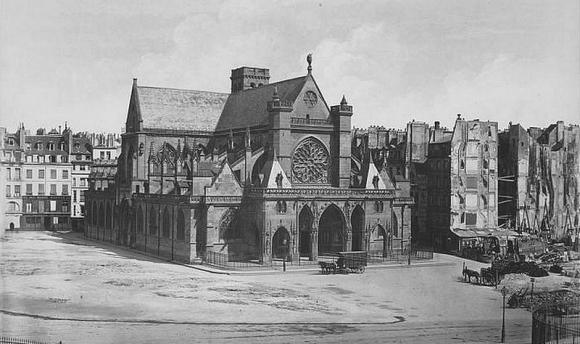
Théodoric I becomes king the Wisigoths
Théodoric I becomes king the Wisigoths during the succession of invasions and battles that take place in former Roman Gaul during the fall of the Western Roman Empire. He dies in battle against Attila in 451, a battle which nevertheless represents the failure of Attila’s invasion into Gaul. The aforementioned Genevieve is given some of the credit for Attila’s defeat for promoting the notion that God will lend a strong hand to protect the Christian people of Paris from the pagan invaders.
918
Death of Guillaume (William) the Pious, Duke of Aquitaine
It’s hard to find a place for this commemoration in your itinerary other than to note: 1, that Guillaume (about 875-918) founded in 909 the Benedictine Abbey of Cluny in Burgundy whose clout and offspring once radiated throughout Christian Europe and 2, that the oversized region of New Aquitaine partially sits within Guillaume’s vast dominion which also reached down to Toulouse across Auvergne and to Lyon and Burgundy.
1118
Death of Bertrade de Montfort, a Countess-cum-Queen
As any screenwriter knows, all you need to create an intriguing mini-series is a history book and the daily paper. There’s far too much scheming, scandal and feudal power play involved in the life of Berthade (born about 1170) to tell a neat little story about this intriguing beauty. In (very) short, Foulques IV, count of Anjou, repudiated his second wife to marry Bertrade, after which Philippe I, king of France, locked away his first wife so that he could marry Bertrade away from Foulques. The Church (think of them as Congressional leaders) then got involved in accepting, rejecting, excommunicating and finally readmitting the couple. But to think of Bertrande as chattel in this story is to misread medieval intrigue, for she had a son with Foulques and another with Philippe and wished them to become, respectively, count of Anjou and king of France, even though Philippe’s son with his first wife was the legitimate heir. She failed in her efforts and eventually withdrew to a convent.
1218
Founding of Les Sables d’Olonne
Now a seaside and sailing town in Vendée, midway between well-heeled La Baule and the portside charms of La Rochelle, Les Sables d’Olonne is the starting and finishing point of the round-the-world solo yachting race Vendée Globe, which is held every four years, next in 2020.
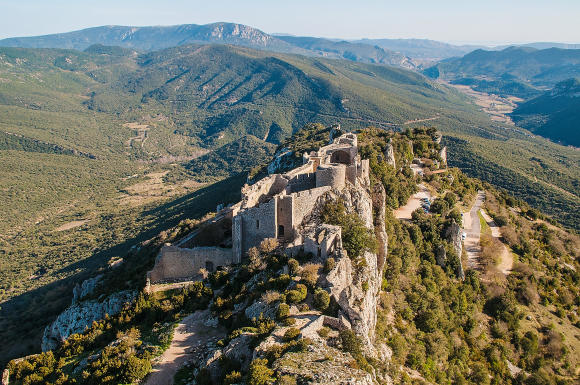
Death of Simon de Montfort, anti-Cathar crusader, Count of Toulouse
Deep into the era of the Crusades, the papal pleasure of seeing the Catholic kings and knights of Europe kill infidels rather than each other was rivaled only by the kingly and knightly pleasure of earning a righteous living through conquest.
When conquest in the Holy Land was elusive, one could always find a heretic to throw into a well or burn at the stake. But local butchery had its limits, so in 1209 Pope Innocent III set in motion the Albigensian or Cathar Crusade to eradicate the Christian-related movement of Catharism that challenged the authoritarian Church. Catharism had grown significantly in southwestern France, particularly in Languedoc, a territory with Carcassonne more or less at its center. Simon de Montfort (born about 1170 of the same Montfort family of the above-mentioned Bertrander) was one of the spearheads of the genocide of the appointed heretics. “Kill them all; God will know his own,” is what the papal legate reportedly said early in the crusade. Perhaps he didn’t really say it, but the instructions and benefits are inevitably clear enough in such matters. Simon’s consecration as a leader of this genocide would come when the pope awarded him the title of Count of Toulouse in 1215. He died in 1218 when crushed by a rock while laying siege to Toulouse, which had revolted against him. Castle ruins perched in the French Pyrenees, where Cathare’s sought refuge, are among the extraordinary sights to be discovered in Cathar Country of southwest France.
1418
Charles the-eventual-VII flees while Bernard VII d’Armagnac gets killed
Every time I read about the conflict between the Burgundians and the Armagnacs during the Hundred Years War between the French and the English it feels like the first time because I can never remember who supports whom in this story in which everyone is more or less related. But I’ve figured this much out: the Armagnacs supported the Orleans clan and the rule of the French king over France, while the wealth of Burgundians depended on trade with the English unless the French king wanted to share some of his tax income. So the Armagnacs and the Burgundians were rivals.
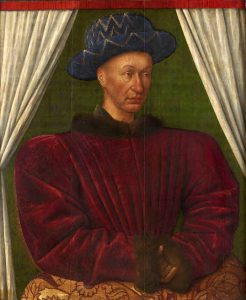
All hell breaks loose when the Duke of Burgundy has the Duke of Orleans (the king’s brother) assassinated in Paris in 1407. Nearly 30 years of civil war ensue while the larger war is also going on. 1418 is a particularly a low period for the French. On May 29, the Burgundians take control of Paris and imprison Bernard VII, leader of the Armagnacs and his cohorts in the city, while Charles, heir to the throne, flees Paris to safety in Bourges, an event that will lead him to be called “the little king of Bourges.” Two weeks later, in the name of fair trade with the English and certainly much else, Parisians break into the prison and massacre Bernard et al. Before long it’s the English that control Paris. In 1435 the French king lay siege to Paris to dislodge the English (mission accomplished a year later), while in the northern town of Arras the Burgundians and the Armagnacs sign a treaty ending the civil war. The Hundreds Year War then slowly winds down as the French reclaim land from the English, ending in 1453.
1468
The Treaty of Péronne
Not that the above ends the Burgundian affection for the English. After all, since Burgundy’s territory at the time reached into Flanders, England was a natural trading partner. With the long period of war generally over, the French king, Louis XI, reaches out to the duke of Burgundy, Charles the Bold, and goes to visit him in Péronne, 85 miles north of Paris. Tensions run high during negotiations until finally the duke and the king agree that they can be friends as long as Louis recognizes that Charles is a pretty powerful guy who can do whatever he wants. Instead of making you wait another nine years to commemorate the (sort of) end of this complex tale, here it is: In 1477 Charles, trying to maintain a connection between Burgundy and his possessions to the north, is killed in battle. Louis XI can then swallow Burgundy and some of its possessions in northern France.
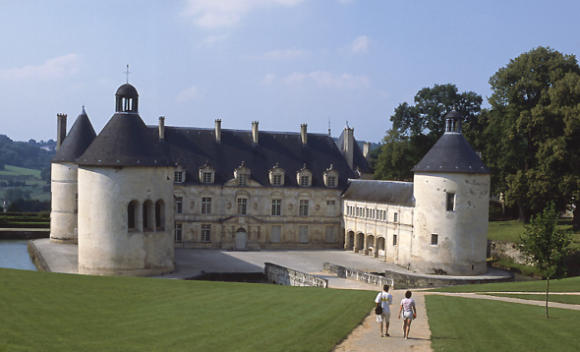
1618
Birth of Count Roger de Bussy-Rabutin
Born in 1618, Bussy-Rabutin might have been known for his military career were it not for his insolence, his wit and his literary talents, which alternately got him exiled to his lands in Burgundy, elected to the French Academy, locked up in the Bastille, exiled again to Burgundy and eventually pardoned by the king. A colorful character, he epitomizes the literary, satirical and libertine culture of the Court of France in the 17th century. He is best known for writing “The Amorous History of the Gauls” (1666), which, to quote the subtitle of its 1727 edition in English, “[Contains] the Intrigues and Gallantries of the Court of France, During the Reign of Louis XIV.” The king was not amused—well, a little. Bussy-Rabutin is also remembered for his maxims on love, such as “Life’s greatest tormentor is the excess of jealousy”; “Love comes from blindness and friendship from knowledge”; “One is never content when in love, but he who doesn’t love is even less happy,” and “Absence is to love what wind is to fire; it extinguishes the small and inflames the great.” He died in 1693. For the traveler, he can be best remembered for the castle of his exile in Burgundy, Château de Bussy-Rabutin, open to the public.
Birth of chef François Pierre de La Varenne, author of “The French Cook”
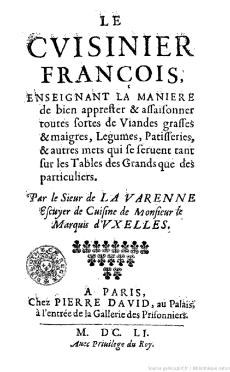 An aristocrat in France of the second half of the 16th century could certainly eat well, what with all the great food products available from around the kingdom, vegetable plants that had been brought from the New World, and recipes circulating in the form of printed books. One could even dine with a certain refinery, thanks to the increasing use of a long fork with which to poke a nibble off one’s plate and lift it over one’s pristine neck ruff. But it was the 17th century that gave wings to French gastronomy and the etiquette to go with it. Chef to the Marquis d’Uxelles, La Varenne (1618-1678) is credited with codifying rules of French cuisine in his 1651 book “The French Cook.” Its full, original title can be seen on the cover. The book can be read on Gallica, site of the French National Library.
An aristocrat in France of the second half of the 16th century could certainly eat well, what with all the great food products available from around the kingdom, vegetable plants that had been brought from the New World, and recipes circulating in the form of printed books. One could even dine with a certain refinery, thanks to the increasing use of a long fork with which to poke a nibble off one’s plate and lift it over one’s pristine neck ruff. But it was the 17th century that gave wings to French gastronomy and the etiquette to go with it. Chef to the Marquis d’Uxelles, La Varenne (1618-1678) is credited with codifying rules of French cuisine in his 1651 book “The French Cook.” Its full, original title can be seen on the cover. The book can be read on Gallica, site of the French National Library.
1668
Creation of L’Avare (The Miser) by Molière (1622-1673)
The comedy, a standard in the French repertory, was first performed at the Palais Royal Theater in 1668.
First publication of the Fables of Jean de La Fontaine
Where there is Molière, La Fontaine (1621-1695) is surely nearby since the two were contemporaries and major figures of 17th-century French letters. Their remains were even eventually brought side by side at Père Lachaise Cemetery in Paris. La Fontaine is best known for his fables, some of which can be read here. A museum dedicated to La Fontaine occupies the house in Château-Thierry where he was born.
Birth of composer Jean Gilles
Traveling Baroque music lovers might keep an ear out for Gilles’ Requiem since the French composer was born 350 years ago this year in Tarascon, between Avignon and Arles. Completed toward the end of his life, the Requiem was played at his own funeral in 1705 and at many others to follow, including those of Rameau in 1764 and Louis XV in 1774. Gilles’ Requiem and Mozart’s Requiem are on the program for a concert at the Royal Chapel of Versailles on June 26, 2018. Ticket information here.
Birth of composer François Couperin
Born into a musical family in Paris, Couperin’s compositions for the harpsicord will also get a hearing in various settings this year. He died in 1733.
1718
Founding of New Orleans
This year New Orleans celebrates the tercentennial of its founding as a French colony. It was named in honor of the Philippe, Duke of Orleans, who was at the time regent during the youth of King Louis XV, his first cousin once removed. The French town of Orleans, on the northernmost bend of the Loire River, is also celebrating the anniversary. The two cities recently signed a sister city pact. For more details see this article.
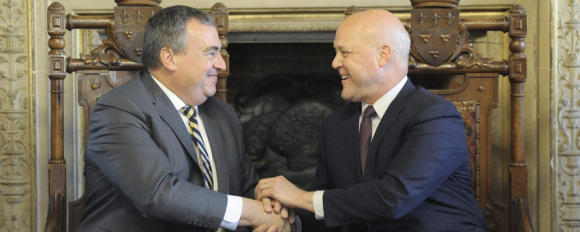
1768
The Genoese Republic cedes Corsica to France
Just in time for Napoleon Bonaparte to be born there as a Frenchman. The French nevertheless had to conquer the island. But some Corsicans are still fighting for independence.
Death of Marie Leszczynska, Louis XV’s queen
Marie Leszczynka, Louis XV’s Polish queen, was a trooper. They married when she was 22, he was 15. A true love, it appeared at first, at least a hot-blooded affair, and they made a fertile pair—she gave birth to 10 children in 10 years, including one set of twins. He then set her aside and she graciously and dutifully stayed there as he pursued his life as a lustful king. She died in 1668 at the age of 42, the last queen of France to die as queen (neither deposed, beheaded or widowed). Her memory is often overshadowed by talk of the Louis XV’s mistresses, from the four Mailly-Nesle sisters to the impressive Madame de Pompadour to the eventually beheaded Madame du Barry.
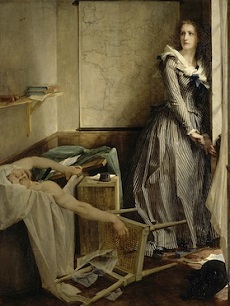
Birth of Charlotte Corday who assassinated Marat
Born in Normandy, Charlotte Corday died on guillotine in 1793 four days after assassinating, in his bathtub, Jean-Paul Marat, a major figure of the French Revolution. Read this article on France Revisited about Corday and the assassination.
1818
Birth of composer Charles Gounod
First performed (in Paris) in 1859, Gounod’s Faust nears the top of the hit parade of famous French operas. (Bizet’s Carmen naturally tops the list.) An aria or two of Gounod’ Romeo and Juliet may also ring a few bells. On June 14, 2018 the Théâtre des Champs-Elysées in Paris will host a concert version of Faust.
France and other European nations abolish the slave trade
Louis X had abolished slavery in France way back in 1315, as did many rulers in Europe. But with expansion in the New World, France and its European rivals pursued the development of their colonies with the help of the slave trade, which took the form of a navigational triangle that took Black Africans to the Americas and returned to home ports with raw materials from across the ocean. In 1818 France, under Louis XVIII, abolishes the slave trade, as did Britain, Spain, Portugal and The Netherlands at about the same time, altogether a part of the reordering of Europe following the Napoleonic Wars. It then took another 30 years for slavery itself to be abolished in French colonies.
Creation of the savings bank, Caisse d’Epargne, in France
The creation of a new type of in banking in France which allows those of any means, sex or age to place money in a bank for savings and interest.

Henri IV back in the saddle on the Pont Neuf
None of the royal statues that one sees in Paris is the original on their given site since they were all destroyed during the Revolution. (A Louis XIV from City Hall survived that is the Carnavalet Museum in the Marais). Copies began to be placed on pedestals with the return of the Bourbons with Louis XVIII after the fall of Napoleon. The most notable and majestic of these is the equestrian statue of Henri IV placed on the bridge Pont Neuf in 1818. Pieces of the original, particularly the hand of power, are also in the Carnavalet Museum.
1868
Death of Léon Foucault of pendulum fame
Like Eiffel’s tower, Foucault’s pendulum is a deceptively simple answer to a complex question. The former answers the question of how to build something 1000 feet high; the latter gives visual evidence of Earth’s rotation. In 1851 Foucault (born in Paris in 1819) set up a public scientific demonstration of his pendulum beneath the dome of the Pantheon in Paris. In 1995 a pendulum was given permanent place of honor there. A pendulum also swings at the national Museum of Technology (Musée des Arts et Métiers). Foucault also helped define to great precision the speed of light, providing a figure that is just 0.006% from the most precise number known today. See the pendulum at the Pantheon in this France Revisited video.
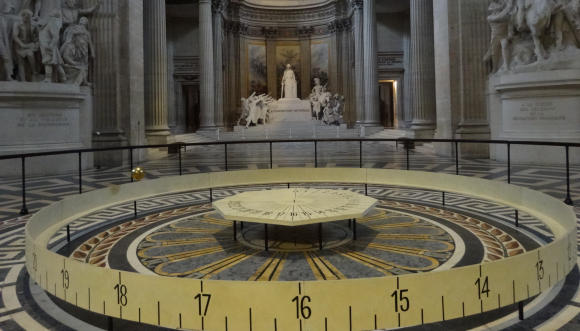
Birth of Gaston Laroux, creator of the Phantom
Author of The Phantom of the Opera (1910 for the book) and other fantastic tales and detective stories. He died in 1927.
Birth of Edmond Rostand, playwright of Cyrano
Born in Marseille, his play Cyrano de Bergerac has been a crowd-pleaser ever since it was first performed in 1897. He is also the author of L’Aiglon, a play about Napoleon’s son, first performed in 1900 with Sarah Bernhardt in the role of the young man. Rostand died in 1918 in Paris.
1918
Battles and Armistice ending the First World War
Millions more die in during the final year of fighting of the First World War before the armistice of Nov. 11, whose centennial will be commemorated this year. While Americans entered the war on the side of the Allies in 1917, their engagement on the front takes place in 1918, so several American war centennial commemorations will be held in France this year. You don’t need a commemoration, however, to visit the American WWI sights and cemeteries France such as the Escadrille Lafayette Memorial, those near Chateau-Thierry and those in the Meuse.
The “Spanish” flu
The flu pandemic known as the Spanish flu spans the globe, killing tens of millions in 1918 and 1919.
Other obituaries of 1918:
Composer Claude Debussy, poet Guillaume Apollinaire, playwright Edmond Rostand and aviator Roland Garros who was shot down during war and for whom the French Open tennis tournament is named.
1968
May 68
Analyzing the effect of May 68 and positioning oneself with respect to that era will be one of the top intellectual exercises and parlor games of France of the coming months. The labor, social and student movements of the spring of 1968 that are known as May 68 brought together the anger, the frustration, the calls for change and action, and the expression of anti-establishment and anti-authoritarian ideals of a multi-faceted group of students, laborers, leftists, anarchists, and others demanding greater freedoms, rights, power and justice. The Vietnam War was going on, “race riots” had become frequent in the United States, the Cold War thrived, the sexual revolution was underway, youth power had taken to the airwaves ad to the streets, Charles de Gaulle was president of France. There were massive strikes, barricades, joyful and intense disorder, slogans and demands everywhere, occupied buildings (most notably the Sorbonne and the Odeon Theater in Paris), a political crisis. An essential reference point in French history of the second half of the 20th century.
René Cassin receives the Nobel Peace Prize
Cassin (1887-1976) once said “The more I feel French, the more I feel human.” It was for feeling human that he received the Nobel Prize, or more specifically for his work in defining, defending and promoting human rights. He was one of the authors of the Universal Declaration of Human Right, developed by the United Nations by a commission presided by Eleanor Roosevelt and adopted in Paris in 1948. He served as the first president of the European Court of Human Rights. He is entombed in the Pantheon.
The full list from the High Committee for National Commemorations can be found here. The Center for Historical Monuments publishes a book each year about the selected anniversaries.
© 2018, Gary Lee Kraut

